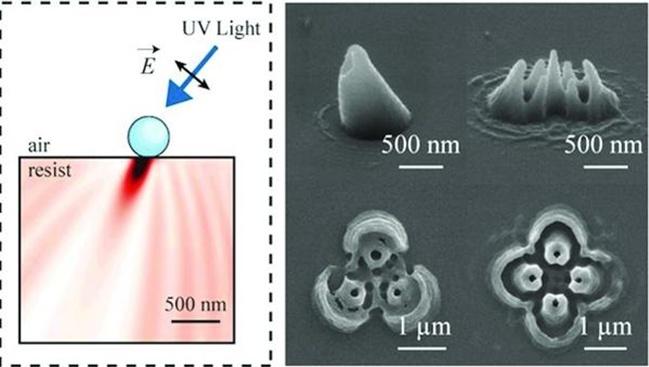It’s called ‘nanolithography,’ and researchers say it’s a process which takes advantage of transparent nanoscale spheres to build three-dimensional structures aimed at creating pieces for electronic, biomedical, and perhaps even photonic applications.
Significantly less expensive than conventional methods, the researchers — led by Dr. Chih-Hao Chang, an assistant professor of mechanical and aerospace engineering at North Carolina State University — say this latest innovation doesn’t rely on traditional methods to create 3D structures.
“We are using the nanosphere to shape the pattern of light,” Dr. Chang says, “which gives us the ability to shape the resulting nanostructure in three dimensions without using the expensive equipment required by conventional techniques. It allows us to create 3D structures all at once, without having to make layer after layer of 2D patterns.”

These minute structures were created at North Carolina State University with a process researchers call ‘nanolithography,’ which promises to revolutionize technologies from electronics to biomedicine with an array of tiny, inexpensive devices.
Dr. Chang says he and his team at NC State are taking a different approach which involves placing nanoscale polystyrene spheres directly onto the surface of a photosensitive film.
The transparent nanospheres are capable, despite their near clarity, of bending and scattering light that passes through them in predictable ways. The output of the process is controlled by altering the size of the nanospheres and the time frame of the light exposures. The process also relies on precise control of the angle, wavelengths, and polarization of the light source.
With a single beam of light — or with multiple beams — Dr. Chang says the technique is capable of rendering a wide array of nanostructure designs.
And it can do them for very little investment.
“Our approach reduces the cost of nanolithography to the point where it could be done in your garage,” Dr. Chang says.
The work is essentially a demonstration based on “oblique illuminations of colloidal particles to fabricate hollow-core 3D nanostructures with complex symmetry.” As part of the process, light-particle interaction governed by Mie scattering sculpts novel 3D structures which feature high pattern versatility, and perhaps most importantly, low cost.
The researchers say they see potential applications for their method in creating nanoneedles, nanonozzles, and materials with anisotropic properties. That is, the materials exhibit properties with different values when measured in different directions. They’ve also shown they can make nanospheres self-assemble, and they say that ability can be used to create a uniform pattern of 3D constructs.
Co-authored by undergraduates Bin Dai and Zhiyuan Xu, the work was supported by funding from the NASA Early Career Faculty and by the Nanosystems Engineering Research Center for Advanced Self-Powered Systems of Integrated Sensors and Technologies at NC State.
If you’d like to further explore the results, you can check out the paper the NC State team produced, Sculpting Asymmetric Hollow-Core Three-Dimensional Nanostructures Using Colloidal Particles. Share your insights into nanostructures and nanotechnology with us in the Low-Cost 3D Printed Nanostructures thread on 3DPB.com.
Subscribe to Our Email Newsletter
Stay up-to-date on all the latest news from the 3D printing industry and receive information and offers from third party vendors.
You May Also Like
Precision at the Microscale: UK Researchers Advance Medical Devices with BMF’s 3D Printing Tech
University of Nottingham researchers are using Boston Micro Fabrication‘s (BMF) 3D printing technology to develop medical devices that improve compatibility with human tissue. Funded by a UK grant, this project...
3D Printing Webinar and Event Roundup: April 21, 2024
It’s another busy week of webinars and events, starting with Hannover Messe in Germany and continuing with Metalcasting Congress, Chinaplas, TechBlick’s Innovation Festival, and more. Stratasys continues its advanced training...
3D Printing Webinar and Event Roundup: March 17, 2024
It’s another busy week of webinars and events, including SALMED 2024 and AM Forum in Berlin. Stratasys continues its in-person training and is offering two webinars, ASTM is holding a...
3D Printed Micro Antenna is 15% Smaller and 6X Lighter
Horizon Microtechnologies has achieved success in creating a high-frequency D-Band horn antenna through micro 3D printing. However, this achievement did not rely solely on 3D printing; it involved a combination...































